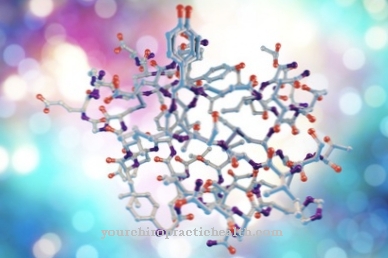Peristalsis represents the muscle movement of various hollow organs. This is where the non-propulsive peristalsis mainly in the intestines. It serves to mix the intestinal contents.
What is non-propulsive peristalsis?

Peristalsis describes the rhythmic muscle movement of various hollow organs such as the esophagus, stomach, intestines or ureters. The non-propulsive peristalsis is only important for the intestine. It is not used for transport, but ensures that the intestinal contents in the small intestine or large intestine are well mixed.
Peristalsis is characterized by a wave-like movement of the hollow organs. In the case of the digestive tract, the movements are mainly responsible for the transport and mixing of the chyme, which moves via the esophagus, stomach and intestines to the anus.
There are three forms of peristalsis. These include propulsive, non-propulsive and retrograde peristalsis. In propulsive peristalsis, the intestinal contents are transported in the aboral direction (towards the anus). The retrograde peristalsis transports the chyme back again. This happens, for example, when vomiting.
The non-propulsive peristalsis is characterized by a rhythmic segmentation and pendulum movement, which constantly mixes the chyme or the intestinal contents without transporting them further. Due to the non-propulsive peristalsis, the intestinal passage takes up to 36 hours.
Function & task
After the passage through the gastric porter, the non-propulsive peristalsis of the small intestine begins with the entry of the porridge into the duodenum. This leads to rhythmic movements of the intestine, which are known as segmentations.
As part of these movements, the digestive secretions of the pancreas are added to the chyme and mixed further. At the same time, however, propulsive peristalsis also takes place, which transports the chyme onwards. Important nutrients are absorbed through the movements of the villi.
Both propulsive and non-propulsive bowel movements occur in the small intestine. The intestinal contents are slowly transported in the aboral direction and first reach the large intestine (colon). Mainly non-propulsive bowel movements take place in the colon. The intestinal contents are further mixed, thickened and stored. The main movement in the colon consists of segmentations for mixing. This results in long transit times for food residues. On average, a complete passage of the intestinal contents takes about 30 to 36 hours. As part of the segmentation, the intestinal contents often remain in the same place for a long time. There is usually no further transport with these movements.
Only rarely, about once to three times a day, does a propulsive mass movement of the intestinal contents suddenly occur in the direction of the rectum. This mass movement is triggered by a gastrocolic reflex after a meal. By stimulating the stomach receptors, a signal is passed on to the colon via the autonomic nervous system, whereupon the propulsive mass movement takes place. This sudden mass movement is the only way to transport the intestinal contents to the anus and initiate defecation.
The main component of intestinal movement, however, consists of non-propulsive peristalsis, which, in addition to mixing, also contributes to the storage of the intestinal contents. During segmentation, the contraction waves of the intestinal muscles run both aborally and antiperistaltically. Due to the long retention of the intestinal contents in the ascending colon (part of the large intestine), sufficient water, electrolytes and fatty acids can still be absorbed. In addition, some food components are broken down and utilized by bacteria.
The bowel movement is mainly controlled by the autonomic enteric nervous system. The rare mass movement requires a signal from the direction of the stomach, which is passed on to the colon by the vegetative nervous system.
The segmentations lead to ring-shaped constrictions which, together with the constantly increased tone of the longitudinal muscle strips (tänien), lead to bulging (bulging of the intestinal wall). The intestinal contents are stored in the house for a long time and can therefore still serve as a source of important nutrients.
You can find your medication here
➔ Medication for diarrheaIllnesses & ailments
As already mentioned, the non-propulsive peristalsis increases the length of time the intestinal contents remain in certain areas of the large intestine. However, if the segmental contraction of the circular muscles of the large intestine is decreased, then a disorder of the non-propulsive peristalsis is present. In this case there is an accelerated intestinal passage of the intestinal contents. This results in thin diarrhea. Due to the shorter retention time in the intestine, not enough fluid can be withdrawn from the intestinal contents.
The causes of disorders of non-propulsive peristalsis can be varied. Often there is a vegetative-functional diarrhea. It is caused by an increased sympathetic tone in the case of fear or stress. Diarrhea can also occur in the context of irritable bowel syndrome. Psychological factors that influence intestinal peristalsis also often play a major role here.
In diabetic polyneuropathy, various nerves are damaged, which can also lead to disorders in the non-propulsive peristalsis, which can lead to both diarrhea and constipation. The fine-tuned relationship between propulsive and non-propulsive peristalsis is disturbed. Depending on which nerves are affected, polyneuropathies can lead to watery diarrhea or, on the contrary, a megacolon. A megacolon is characterized by chronic constipation and an enlarged colon.
Hormonal diseases also often play a major role in intestinal motility. For example, hyperthyroidism (overactive thyroid) also causes an accelerated intestinal transit. In addition, many chronic bowel diseases have an impact on the function of the circular muscles in the intestine and cause either an accelerated or delayed intestinal passage.













.jpg)

.jpg)
.jpg)










.jpg)